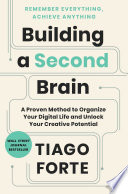

The author, Tiago Forte, introduces the concept of a 'Second Brain,' which refers to a digital system for storing, organizing, and retrieving information. This system is designed to complement our biological brain, allowing us to manage the overwhelming amount of information we encounter daily. The Second Brain is built on the premise that our minds are not designed to remember everything; instead, we can use technology to enhance our cognitive abilities. By creating a digital repository for notes, ideas, and resources, we can free up mental space for creativity and critical thinking. The Second Brain acts as an external memory system, where we can capture insights, organize them in a meaningful way, and retrieve them when needed. This approach not only improves productivity but also fosters a sense of clarity and focus in our work and personal lives.
Continue readingForte introduces the PARA method, which stands for Projects, Areas, Resources, and Archives. This organizational framework helps individuals categorize their digital information effectively. Projects represent short-term efforts with a specific goal, Areas encompass ongoing responsibilities, Resources are valuable materials that support both projects and areas, and Archives contain inactive items that are no longer in use. By using the PARA method, individuals can streamline their information management, ensuring that everything is in its rightful place. This structured approach not only makes it easier to find information but also helps prioritize tasks and maintain focus on what truly matters. The PARA method is a key component of building a Second Brain, as it provides a clear and systematic way to manage the digital clutter that can overwhelm us.
Continue readingProgressive summarization is a technique that involves distilling information into increasingly concise and useful forms. This method encourages individuals to revisit their notes and materials, summarizing them progressively to extract the most important insights. The process typically involves multiple rounds of summarization, where the initial notes are condensed into key points, and then those points are further distilled into even shorter summaries. This technique not only helps reinforce learning but also makes it easier to recall and apply information in the future. By engaging with the content multiple times, individuals deepen their understanding and create a more robust mental framework for the information. Progressive summarization is particularly useful for knowledge workers who need to synthesize large amounts of information regularly.
Continue readingForte advocates for a Just-in-Time (JIT) approach to project management, which emphasizes the importance of working on tasks and projects only when they are needed. This method contrasts with traditional project management, which often involves extensive planning and organization before execution. The JIT philosophy allows individuals to remain agile and responsive to changing circumstances, reducing the cognitive load associated with long-term planning. By focusing on immediate tasks and deferring others until necessary, individuals can maintain a clearer mind and avoid the overwhelm that often comes with managing multiple projects at once. This approach aligns well with the principles of a Second Brain, as it encourages a flexible and dynamic way of working that adapts to the flow of information and priorities.
Continue readingReflection is a crucial component of building a Second Brain, as it allows individuals to process their experiences, insights, and learning. Forte emphasizes the need to regularly review and reflect on the information captured in the Second Brain. This practice not only reinforces learning but also helps identify patterns, connections, and areas for improvement. By setting aside time for reflection, individuals can gain a deeper understanding of their work and personal development, leading to more informed decision-making and creative thinking. Reflection also serves as an opportunity to evaluate the effectiveness of the Second Brain system itself, ensuring that it continues to meet evolving needs and goals.
Continue readingForte encourages readers to develop a personalized knowledge management system tailored to their unique needs and preferences. This system should integrate various tools and technologies to capture, organize, and retrieve information effectively. The process involves selecting the right software, creating workflows, and establishing routines that support information management. A well-designed personal knowledge management system enhances productivity, creativity, and learning. It allows individuals to harness their knowledge and experiences, transforming them into actionable insights. By creating a system that aligns with their working style, individuals can maximize the benefits of their Second Brain and achieve their personal and professional goals.
Continue readingForte discusses the role of technology in enhancing creativity and innovation. He argues that technology should be seen as an extension of our cognitive abilities, enabling us to think more deeply and creatively. By leveraging digital tools and systems, individuals can capture and organize their ideas, collaborate with others, and access a wealth of information that inspires new thinking. The Second Brain serves as a platform for creative exploration, allowing individuals to experiment with ideas and concepts without the fear of losing valuable insights. By embracing technology as a partner in the creative process, individuals can unlock new possibilities and drive innovation in their work and personal lives.
Continue reading